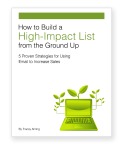5 Steps to Creating Landing Pages That Convert
If you’re not using—or have given up on—landing pages, then you’re missing out on a truly integral component of the sometimes complex B2B sales cycle.
Whether used as part of a lead or sales funnel . . . integrated into an email, PPC, or direct mail campaign . . . a well-crafted landing page can really boost your conversion rates.
Now there are potentially hundreds of specific steps you can take in order to get the most out of them. And there are, of course, various ways to test each page element.
Am I recommending that you ignore all the testing and tweaking? Of course not.
But if you want to get the most bang for your buck, you can’t afford to ignore the basics.
So without further ado, here are five steps to creating landing pages that convert.
1. Determine the goal.
The lack of a clearly defined goal is probably the single biggest stumbling block for most people.
If your pages contain six different ideas, all competing for attention, then you’re in for a disastrous conversion experience.
For example, if you’ve recently published three white papers, it would be a huge mistake to design one landing page for all of them.
Studies consistently show that vague or competing themes are a huge factor in the overall success or failure of a landing page. So instead of cramming multiple ideas onto one page, be sure to create a separate one for each.
If you follow this one step alone, you’ll likely see at least a double digit improvement in your conversion rate.
2. Keep it consistent.
Let’s say you regularly engage in a lead nurturing email program, sending out not only a regular e-newsletter, but periodic links to various offers as well.
And in each of your emails, you maintain a look and feel that’s consistent with your brand image.
But then you design a landing page that not only takes visitors to a site inconsistent with that image, you also send them to a site that doesn’t even pick up where the email offer left off.
Congratulations. You’ve just committed two landing page faux pas.
In order for visitors to feel comfortable when they reach your landing page, they need to be sure about where they are. And it’s matching the branding, tone, and offer to the original email that helps them do that.
If you maintain this consistency in all your landing pages, you’ll not only build greater trust with your customers, you’ll also increase the chances visitors actually stay on the page.
3. State the benefits.
If you really want to increase your response rate, visitors arriving at your landing page must be given compelling reasons why they should take action.
Whether you want them to download a free white paper, register for an event, or purchase a product, customers need to know what’s in it for them.
You might consider using bullet points to list these benefits—ranking each according to how important they are to your prospect—as bullets stand out and appeal to skimmers.
You also might think about using the most substantial benefit as the inspiration for your attention grabbing headline.
4. Minimize distractions.
One of the easiest ways to sidetrack visitors to your landing page is to include a bunch of unrelated links, graphics, or text.
The majority of web users are already overwhelmed with choices, so if you provide too many, your conversion rate will suffer.
Instead, be sure to help your visitors stay focused by avoiding anything that does not directly contribute to the action you’re trying to get them to take.
This means removing unrelated links, images, or outside navigation.
The most successful landing pages are clean and focused, funneling visitors down a streamlined path to one destination and one destination only—the call to action.
5. Don’t ask for too much.
How many times have you visited a landing page whose registration form requested far more information than you were willing to give?
I’ve visited quite a few who requested too much, and I can tell you they put me right off—off the page entirely.
But B2B landing pages enter the realm of “too much information” way too often.
In fact, according to the recently released Demandbase and Focus.com 2011 National Website Demand Generation Study, a full 27% of companies use registration forms that contain eight or more fields.
Eight!
I mean, does someone really need that much information in order to give me access to their white paper?
I don’t think so.
And neither should you.
In the world of landing pages, less is definitely more. So don’t ask for more than you absolutely, positively need. In most cases, this should be no more than email and name.
At the very most, you might add company name and phone number. But anything more than that and your conversion rate will only fall lower and lower.
There really is no substitute for the basics of good design.
By making the above five steps the backbone of your landing pages, your hard work will begin to pay off in your conversions—and your bottom line.
Return to articles




